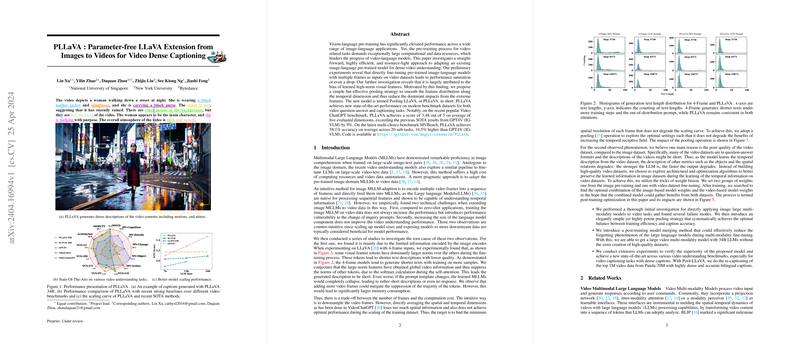Enhancing Dense Video Understanding with Pooling Strategy in LLMs
Introduction and Motivation
The adaptation of Image-LLMs (MLLMs) to the video domain presents unique challenges, primarily due to the inherent complexity and resource demands of video data. Conventional approaches often struggle with computational efficiency and require extensive data annotation. This research paper introduces a novel methodology, Pooling LLaVA (PLLaVA), which leverages a pooling strategy to adapt pre-trained image-LLMs for enhanced video understanding. The proposed method overcomes the limitations of direct frame feature fine-tuning and sets new performance benchmarks on video question-answer and captioning tasks.
Key Findings and Methodology
PLLaVA introduces a simple yet effective pooling operation to manage the temporal dimension of video data, addressing the issue of biased and high-norm visual features that hamper model performance. This pooling strategy not only maintains the richness of frame-level information but also significantly reduces computational overhead.
Technical Challenges Identified
- Direct application of image MLLMs to video tasks using multiple frames as inputs often leads to performance saturation or decline.
- A fine-tuning approach that incorporates multiple video frames frequently results in a bias towards dominant high-norm visual features, leading to reduced descriptive quality and length.
Pooling Strategy
- The pooling approach is designed to smooth the feature distribution along the temporal dimension, minimizing the influence of extreme features and enhancing the overall video description capability of the model.
- PLLaVA utilizes an adaptive pooling module that efficiently condenses the video features without sacrificing critical spatial or temporal information, facilitating a more robust understanding of video content.
Experimental Validation
PLLaVA's effectiveness is demonstrated through extensive experiments across multiple standard video understanding benchmarks. Notably, it surpasses previous state-of-the-art models on the Video ChatGPT benchmark by significant margins, achieving superior performance in detailed video captioning and question-answering tasks.
Key Results
- On the Video ChatGPT benchmark, PLLaVA achieved a score of 3.48 out of 5 across different evaluation dimensions, exceeding the previous SOTA by 9%.
- In the MVBench multi-choice question answering benchmark, PLLaVA achieved an average accuracy of 58.1% across 20 sub-tasks, marking a 14.5% improvement over the nearest competitor.
Implications and Future Work
The success of PLLaVA in handling dense video understanding tasks indicates a promising direction for further explorations in video-LLM training. The pooling strategy effectively addresses the challenge of feature dominance and opens new avenues for efficient video data processing within the constraints of current computational resources. Future studies may explore the adaptability of the pooling approach to different types of video content and its integration with other multimodal training frameworks.
Conclusion
PLLaVA represents a significant step forward in the adaptation of image-LLMs for video understanding tasks. By introducing an efficient pooling strategy, this model not only achieves new benchmarks in video question-answering and captioning but also enhances the model's ability to handle dense and complex video data. This research provides a solid foundation for future advancements in video-LLMing, promoting deeper and more efficient multimodal interactions.
